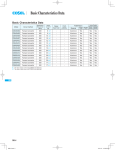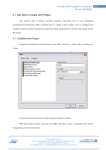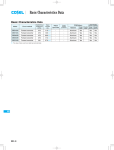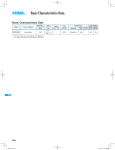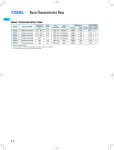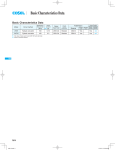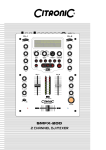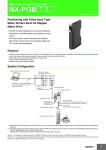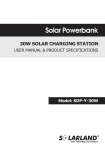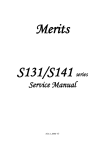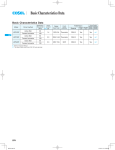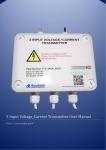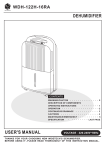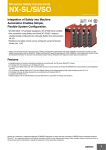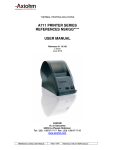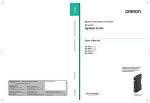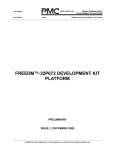Download Basic Characteristics Data
Transcript
Basic Characteristics Data Basic Characteristics Data Model Circuit method Switching frequency [kHz] CDS4004802 Forward converter 360 CDS4004803 Forward converter 360 CDS4004805 Forward converter CDS4004807 CDS4004812 Material Single sided Series/Parallel operation availability Double Series Parallel sided operation operation - Aluminum Yes Yes Yes - Aluminum Yes Yes Yes - - Aluminum Yes Yes Yes 10 *1 - - Aluminum Yes Yes Yes 12 *1 - - Aluminum Yes Yes Yes - - Aluminum Yes Yes Yes - - Aluminum Yes Yes Yes - - Aluminum Yes Yes Yes - - Aluminum Yes Yes Yes Input current [A] Rated input fuse Inrush current protection 6 *1 - 9 *1 - 360 10 *1 Forward converter 360 Forward converter 360 CDS4004815 Forward converter 360 12 *1 CDS4004824 Forward converter 360 12 *1 CDS4004828 Forward converter 360 12 *1 CDS5002428H Forward converter 360 24 *2 PCB/Pattern CDS6002412 Forward converter 360 30 *2 - - Aluminum Yes Yes Yes CDS6002412H Forward converter 360 29 *2 - - Aluminum Yes Yes Yes CDS6002428 Forward converter 360 30 *2 - - Aluminum Yes Yes Yes CDS6002428H Forward converter 360 29 *2 - - Aluminum Yes Yes Yes CDS6004812 Forward converter 360 17 *1 - - Aluminum Yes Yes Yes CDS6004828 Forward converter 360 17 *1 - - Aluminum Yes Yes Yes *1 The value of input current is at DCIN48V and rated load. *2 The value of input current is at DCIN24V and rated load. CDS CDS-6 DC-DC Converters Power Module type Instruction Manual 1 Pin Connection CDS-8 2 Connection for Standard Use CDS-8 3 Wiring Input/Output Pin CDS-9 4 5 6 7 3.1 Wiring input pin 3.2 Wiring output pin Function CDS-9 CDS-10 CDS-10 4.1 Overcurrent protection CDS-10 4.2 Overvoltage protection CDS-10 4.3 Thermal detection/Thermal protection CDS-10 4.4 Inverter operation monitor CDS-10 4.5 Remote ON/OFF CDS-11 4.6 Remote sensing CDS-11 4.7 Adjustable voltage range CDS-12 4.8 Isolation CDS-12 Series and Parallel Operation CDS-12 5.1 Series operation CDS-12 5.2 Parallel operation/Master-slave operation CDS-12 5.3 N+1 redundant operation CDS-13 Implementation Mounting Method CDS-13 6.1 Mounting method CDS-13 6.2 Stress onto the pins CDS-14 6.3 Cleaning CDS-14 6.4 Soldering CDS-14 6.5 Derating CDS-14 Safety Considerations CDS-14 CDS-7 CDS DC-DC Converters Power Module type lCDS500/600 Table 1.2 Pin Connection and function 1 Pin Connection lCDS400 No. CB VB TMP RC3 RC2 RC1 -VIN Instruction Manual -VOUT 21 TRM +S -S IOG AUX +VIN Pin Connection +DC input -VIN -DC input RC1 Remote ON/OFF(Input side) +VOUT +DC output -VOUT -DC output CB Current balance VB Voltage balance TMP Thermal detection signal RC3 +VOUT RC2 4-FG lCDS500/600 CB VB TMP RC3 RC2 RC1 21 -VIN Adjustment of output voltage +S +Remote sensing 21 -S -Remote sensing 22 IOG Inverter operation monitor 23 AUX Auxiliary power supply FG Mounting hole(FG) TRM +S -S IOG AUX No. +VIN Pin Connection +VIN +VOUT -VIN RC1 4-FG +VOUT Fig.1.1 Pin Connection(bottom view) CDS lCDS400 No. Pin Connection 4.5 ”Remote ON/OFF” 3.2 ”Wiring output pin” 5.2 ”Parallel operation/Master-slave operation” VB 4.3 ”Thermal detection/Thermal protection” +DC input TMP -DC input RC3 RC1 Remote ON/OFF(Input side) RC2 +VOUT +DC output TRM -VOUT -DC output +S CB Current balance 21 -S VB Voltage balance 22 IOG 4.4 ”Inverter operation monitor” TMP Thermal detection signal 23 AUX 4.5 ”Remote ON/OFF” FG 3.1 ”Wiring input pin” Remote ON/OFF(output side) TRM Adjustment of output voltage +S +Remote sensing -S -Remote sensing IOG Inverter operation monitor AUX Auxiliary power supply FG Mounting hole(FG) Pin Connection -VIN RC1 +VOUT -VOUT CB VB TMP RC3 RC2 TRM +S -S CDS-8 3.1 ”Wiring input pin” -VIN +VIN 21 CB Function Reference +VIN RC2 No. -VOUT Table 1.1 Pin Connection and function RC3 21 Remote ON/OFF(output side) TRM -VOUT 23 22 Function +VIN Reference 3.1 ”Wiring input pin” 4.5 ”Remote ON/OFF” 3.2 ”Wiring output pin” 4.5 ”Remote ON/OFF” 4.7 ”Adjustable voltage range” 4.6 ”Remote sensing” 2 Connection for Standard Use nIn order to use the power supply, it is necessary to wire as shown in Fig.2.1. Reference: 3 6.5 ”Wiring Input/Output Pin” ”Derating” nShort the following pins to turn on the power supply. 5.2 ”Parallel operation/Master-slave operation” 4.3 ”Thermal detection/Thermal protection” 4.5 ”Remote ON/OFF” 4.7 ”Adjustable voltage range” 4.6 ”Remote sensing” IOG 4.4 ”Inverter operation monitor” AUX 4.5 ”Remote ON/OFF” FG 3.1 ”Wiring input pin” -VIN RC1, +VOUT +S, -VOUT -S Reference: 4.5 4.6 ”Remote ON/OFF” ”Remote sensing” nThe CDS Series handles only the DC input. Avoid applying AC input directly. It will damage the power supply. nOperate with the conduction cooling(e.g. heat radiation from the aluminum base plate to the attached heat sink). Reference: 6.5 ”Derating” Instruction Manual Cin DC input Noise filter + Input voltage [V] Heatsink +S +VIN +VOUT + Co -VIN Load -VOUT RC1 FG -S 2V max time Cin : External capacitor on the input side Co : External capacitor on the output side Input voltage range DC-DC Converters Power Module type t Fig.3.1 Input voltage ripple Range of input voltage Input current [A] Fig.2.1 Connection for standard use 3 Wiring Input/Output Pin lp Input voltage [V] 3.1 Wiring input pin Fig.3.2 Input current characteristics (1) External fuse nFuse is not built-in on input side. In order to protect the unit, install the normal blow type fuse on input side. (5) Operation with AC input nThe CDS series handles only for the DC input. nWhen the input voltage from a front end unit is supplied to multiple units, install a regular type fuse in each unit. A front end unit(AC/DC converter) is required when the CDS series is operated with AC input. Table 3.1 Recommended fuse(Normal-blow type, maximum value) Model CDS40048 CDS50024/CDS60024 CDS60048 Rated current 30A 75A 30A CDS (6) Reverse input voltage protection nAvoid the reverse polarity input voltage.It will break the power supply. It is possible to protect the unit from the reverse input voltage by installing an external diode. (2) Noise filter/Decoupling capacitor nlnstall an external noise filter for low line-noise and for stable operation of the power supply. nlnstall a correspondence filter, if a noise standard meeting is required or if the surge voltage may be applied to the unit. (3) External capacitor on the input side nlnstall an external capacitor Cin between +VIN and -VIN input pins DC YES CDS Load CDS Load CDS Load AC NO AC YES for low line-noise and for stable operation of the power supply. AC/DC Converter Fig.3.3 Use with AC input CDS40048: more than 100 F CDS50024/CDS60024: more than 1000 F (a) (b) CDS60048: more than 470 F nWhen the line impedance is high or the input voltage rise quickly at start-up(less than 10 s), install a capacitor Cin between +VIN and -VIN input pins(within 50mm from pins). +VIN DC IN -VIN +VIN DC IN -VIN Fig.3.4 Reverse input voltage protection (4) Input voltage range/Input current range nlnput voltage ripple should be less than 2Vp-p. nMake sure that the voltage fluctuation, including the ripple voltage, will not exceed the input voltage range. nUse a front end unit with enough power, considering the start-up current lp of this unit. CDS-9 DC-DC Converters Power Module type Instruction Manual 3.2 Wiring output pin 4.3 Thermal detection/Thermal protection nlnstall an external capacitor Co between +VOUT and -VOUT pins nThermal detection(TMP) and protection circuit are built-in. nWhen overheat is detected, thermal detection signal(TMP) turns for stable operation of the power supply. Recommended capacitance of Co is shown in Table 3.2. ”L” from ”H”. TMP circuit is designed as shown in Fig.4.1, and specification is Table 3.2 Recommended capacitance Co [ F] Model CDS4004802 CDS4004803 CDS4004805 CDS4004807 CDS4004812 CDS4004815 CDS4004824 CDS4004828 CDS5002428H CDS6002412 CDS6002412H CDS6002428 CDS6002428H CDS6004812 CDS6004828 Capacitance 6800 6800 4700 4700 470 330 220 220 470 1000 1000 470 470 1000 470 shown as in Table 4.1. nWhen overheating continues after detecting the TMP signal, the output will be shut down by the thermal protection circuit. When this function comes into effect, input voltage should be shut off, and eliminate all possible causes of overheat condition and lower the temperature of the unit to the normal level. 4.4 Inverter operation monitor nBy using the inverter operation monitor(IOG), malfunction of the inverter can be monitored. When inverter operation is in following mode nSelect the high frequency type capacitor. Output ripple and start- CDS , or , IOG signal turns ”H” from ”L” within 1 second. up waveform may be influenced by ESR ESL of the capacitor lOG circuit is designed as shown in Fig.4.1and specification is and the wiring impedance. shown in Table 4.1. nlnstall a capacitor Co near the output pins(within 100mm from the Malfunction of inverter. The output voltage drops by 60% or less of the rated voltage. pins). When output wattage is decreased radically to less than 10% of rated wattage. 4 Function 22k 4.1 Overcurrent protection TMP or IOG 6V typ nOvercurrent protection is built-in and comes into effect at over 105% of the rated current. -S Overcurrent protection prevents the unit from short circuit and Fig.4.1 TMP, IOG circuit overcurrent condition. The unit automatically recovers when the fault condition is cleared. nWhen the output voltage drops at overcurrent, the average output current is reduced by intermittent operation of power supply. Table 4.1 Specification of TMP, IOG No. Item 1 Function 4.2 Overvoltage protection 2 Base pin nThe overvoltage protection circuit is built-in. The DC input should 3 Level voltage ”L” 4 Level voltage ”H” 5 Maximum sink current 6 Maximum applicable voltage be shut down if overvoltage protection is in operation. The minimum interval of DC recycling for recovery is for 2 to 3 minutes (*) or input terminal voltage is decreased less than 1V. The recovery time varies depending on input voltage and input capacity. Remarks: Please note that devices inside the power supply might fail when voltage more than rated output voltage is applied to output terminal of the power supply. This could happen when the customer tests the overvoltage performance of the unit. CDS-10 TMP IOG Normal operation ”H” Normal operation ”L” Overheat detection ”L” Malfunction of inverter ”H” -S 0.5Vmax at 5mA 5V typ 10mA max 35V max DC-DC Converters Power Module type Instruction Manual nMake sure that sink current of output side remote ON/OFF circuit 4.5 Remote ON/OFF nRemote ON/OFF circuit is built-in on both side of input(RC1) and should be less than 12mA. output(RC2 RC3). (3) Auxiliary power supply for remote ON/OFF(AUX) Output can be controlled by either circuit. nAUX is built in for operating the output side remote ON/OFF(RC2 RC3). (1) Input side remote ON/OFF(RC1) nThe ground pin of input side remote ON/OFF circuit is ”-VIN” pin. Between RC1 and -VIN: Output voltage is ON at ”Low” Ievel or short circuit(0 - 1.0V). Between RC1 and -VIN: Output voltage is OFF at ”High” Ievel or If AUX is not used for RC2 RC3, AUX can be used for IOG or TMP signal output by opto coupler. nShort protection resistance(2.2k ) is built in. Output voltage decreases as the output current increases. (AUX voltage at open circuit: 16V max) short circuit(3.5 - 7.0V). When RC1 is ”Low” Ievel, fan out current is 0.3mA typ. When Vcc is applied, use 3.5 Vcc 7V. When remote ON/OFF function is not used, please short between RC1 and -VIN. 4.6 Remote sensing (1) When the remote sensing function is not in use nWhen the remote sensing function is not in use, it is necessary to confirm that pins are shorted between +S & +VOUT and between -S & -VOUT. Vcc nWire between +S & +VOUT and between -S & -VOUT as short as Rc RC1 or possible. or Loop wiring should be avoided. This power supply might become unstable by the noise coming -VIN Transistor IC Relay from poor wiring. Fig.4.2 RC1 connection example (2) When the remote sensing function is in use nTwisted-pair wire or shield wire should be used for sensing wire. (2)Output side remote ON/OFF(RC2 RC3) nThick wire should be used for wiring between the power supply Table 4.2 Specification of output side remote ON/OFF(RC2 RC3) No. Item 2 Function 3 Base pin Fig.4.3 (a) Fig.4.3 (b) Fig.4.3 (c) Power ON Power ON Power ON ”H” ”H” ”L” -S RC2 4 Power ON Open (0.1mA max) 5 Power OFF Short (3mA min) (a) (b) 2.2k 2.2k AUX 150 RC3 13V typ 150 RC3 RC2 OFF RC2 POWER ON OFF 13V typ put voltage adjustment range. nIf the sensing patterns are short, heavy-current is drawn and the pattern may be damaged. Short (0.5V max) The pattern disconnection can be prevented by installing the pro- Open (0.1mA max) tection parts as close as a load. +S +VOUT OUT 2.2k AUX 150 RC3 POWER ON OFF POWER ON -S -S Voltage between +VOUT and -VOUT should remain within the out- -S and RC2 (c) AUX 13V typ Line drop should be less than 0.5V. RC2 RC3 Wiring method 1 and a load. + Co Load -VOUT -S Short at pin root RC2 Fig.4.4 Connection when the remote sensing is not in use -S Wire as close as possible Fig.4.3 RC2 RC3 connection example +S nWhen output side remote ON/OFF function is used, please short between RC1 and -VIN. nDo not connect RC2 and RC3 with anywhere if remote ON/OFF is not used. +VOUT OUT + Co Load -VOUT -S Fig.4.5 Connection when the remote sensing is in use CDS-11 CDS DC-DC Converters Power Module type (2) Adjusting method by applying external voltage 4.7 Adjustable voltage range nOutput voltage is adjustable by the external potentiometer or by nBy applying the voltage externally at TRM, output voltage become adjustable. applied voltage externally. CDS5002428H, CDS6002412H, CDS6002428H : When the output voltage adjustment range is 101% or more, the input voltage nOutput voltage is calculated by the following equation. (Output voltage) = (Applied voltage externally) range is limited (Fig.4.6). nWhen the output voltage is raised, decrease the output current so as not to exceed the maximum output wattage. nWhen the output voltage adjustment is used, note that the overvoltage protection circuit operates when the output voltage sets too high. (Rated output voltage) 4.8 Isolation nFor a receiving inspection, such as Hi-Pot test, gradually increase (decrease) the voltage for a start(shut down). Avoid using Hi-Pot tester with the timer because it may generate voltage a few times 120 Output voltage [%] Instruction Manual 114.3 higher than the applied voltage, at ON/OFF of a timer. CDS5002428H CDS6002428H nBe sure to apply DC voltage when Hi-pot test is performed to the CDS6002412H part which is specified as DC voltage. And also set the current 110 limit of Hi-pot tester at 10mA. Don’t apply AC voltage, otherwise 101 this may damage the power supply. 100 (CDS40048 series : INPUT-OUTPUT, INPUT-FG) 18 20 19.5 22 24 20.5 Input voltage [v] 5 Series and Parallel Operation Fig.4.6 Input voltage derating curve (1) Adjusting method by external resistor nBy connecting the external potentiometer(VR1) and resistors(R1, R2), output voltage becomes adjustable, as shown in Fig.4.6, rec- 5.1 Series operation ommended external parts are shown in Table 4.3. nThe wiring to the potentiometer should be as short as possible. nSeries operation is available by connecting the outputs of two or The temperature coefficient becomes worse, depending on the more power supplies, as shown below. Output current in series con- type of a resistor and potentiometer. Following parts are recom- nection should be lower than the lowest rated current in each unit. Metal film type, coefficient of less than 100ppm/ Potentiometer Cermet type, coefficient of less than 300ppm/ (a) + Power supply + nWhen the output voltage adjustment is not used, open the TRM pin and VB pin respectively. (b) Power supply - +VOUT RA 15k + Reference voltage 2.5V RB 10k Power supply + - - Fig.5.1 Examples of series operation R2 VR1 TRM R1 + - +S VB Control Amp. of rated voltage Power supply Load Resistor Load mended for the power supply. Load CDS -S 5.2 Parallel operation/Master-slave operation -VOUT nParallel operation is available by connecting the units as shown in Fig.4.7 Output voltage control circuit Fig.5.2. nAs variance of output current drew from each power supply is Table 4.3 Recommended value of external potentiometer & resistor No. Adjustable range [%] Number of unit 5 CDS-12 10 2sets 3sets R1 36k 1k 36k 18k 12k value determined by the following equation. (Output current in parallel operation) = (the rated current per unit) 24k 5k maximum 10%, the total output current must not exceed the R2 75k 5k Single 4 6 2sets 3sets 3 5 VR1 Single 1 2 External parts value [ ] 910 (number of unit) 0.9 DC-DC Converters Power Module type When the number of units in parallel operation increases, input current increase at the same time. Adequate wiring design for input circuitry is required, such as circuit pattern, wiring and current ca- Instruction Manual nIOG signal might be unstable for one second when the units are turned on in parallel operation. nA sound may occur from power supply at parallel operating. pacity for equipment. 5.3 N+1 redundant operation In parallel operation, the maximum operative number of units is 11. +VOUT +S VB TRM CB -S -VOUT nIt is possible to set N+1 redundant operation for improving reliability of power supply system. nPurpose of redundant operation is to ensure stable operation in R2 R1 VR1 + Co Load the event of single power supply failure. Since extra power supply is reserved for the failure condition, so total power of redundant operation is equal to N-1. +VOUT +S VB TRM CB -S -VOUT + Co +VOUT +S VB TRM CB -S -VOUT + Co The output voltage rises when VR1 is adjusted for the resistance between and to lower. 6 Implementation Mounting Method 6.1 Mounting method nThe unit can be mounted in any direction. When two or more power supplies are used side by side, position them with proper intervals to allow enough air ventilation. Aluminum base plate temperature around each power supply should not exceed the temperature range shown in derating curve. nAvoid placing the DC input line pattern lay out underneath the Fig.5.2 Examples of parallel operation unit, it will increase the line conducted noise. Make sure to leave an ample distance between the line pattern lay out and the unit. nWhen output voltage adjustment is not in use. TRM wiring, R1, R2 and VR are not necessary. nThick wire should be used for wiring between the power supply and load, and line drop should be less than 0.3V. nWhen the output-line impedance is high, the power supply is become unstable. Use same length and thickness(width) wire(pattern) for the current balance improvement. Also avoid placing the DC output line pattern underneath the unit because it may increase the output noise. Lay out the pattern away from the unit. nHigh-frequency noise radiates directly from the unit to the atmosphere. Therefore, design the shield pattern on the printed circuit board and connect its one to FG. The shield pattern prevents noise radiation. nThe maximum current is 25A per input pin and output pin. nConnect each input pin for the lowest possible impedance. Shield pattern nWhen the number of the units in parallel operation increases, input current increases. Adequate wiring design for input circuitry such as circuit pattern, wiring and current for equipment is required. nConnect the sensing line and the power line by one point after RC1 -VIN -VOUT connecting each power supply's sensing pins(+S, -S). In multiple operation, sensing wires should be connected between each +VIN Shield pattern +VOUT units for the muster connection to a load. nOutput current should be 10% or more of the total of the rated output current in parallel operation. If less than 10%, the IOG signal might become unstable, and out- Fig.6.1 Shield pattern lay out(bottom view) put voltage slightly increasing(max5%). CDS-13 CDS DC-DC Converters Power Module type nOption”-M” is available, as shown in Table 6.1. 6.5 Derating Table 6.1 Mounting hole nUse with the conduction cooling(e.g. heat radiation by conduction from the aluminum base plate to the attached heat sink). Mounting hole Standard 3.4 thru Optional : -M Instruction Manual Fig.6.3 shows the derating curve based on the aluminum base M3 tapped plate temperature. In the hatched area, the specification of Ripple and Ripple Noise is different from other areas. 6.2 Stress onto the pins 100 the internal connection may be weakened. As shown in Fig.6.2 avoid applying stress of more than 29.4N(3kgf) on the input pins/output pins(A part) and more than 9.8N(1kgf) to the signal pins(B part). nThe pins are soldered on PCB internally, therefore, do not pull or Load factor [%] nWhen too much stress is applied to the pins of the power supply, 50 0 -20 bend them with abnormal forces. nMounting hole diameter of PCB should be 3.5mm to reduce the -10 0 10 20 30 40 50 60 70 80 85 90 100 Aluminum base plate temperature Tc [ ] stress onto the pins. nFix the unit on PCB(fixing fittings) by screws to reduce the stress Tc:Measuring point onto the pins. Be sure to mount the unit first, then solder the unit. CDS A B A part A B part Fig.6.3 Derating curve Less than 29.4N(3kgf) Less than 29.4N(3kgf) Less than 9.8N(1kgf) Less than 9.8N(1kgf) Less than 9.8N (1kgf) Less than 29.4N (3kgf) 7 Safety Considerations Fig.6.2 Stress onto the pins nTo apply for safety standard approval using this power supply, the following conditions must be met. 6.3 Cleaning nClean the product with a brush. Prevent liquid from getting into the product. Do not soak the product into liquid. nDo not stick solvent to a name plate or a resin case. (If solvent sticks to a name plate or a resin case, it will cause to change the color of the case or to fade letters on name plate away.) nAfter cleaning, dry them enough. 6.4 Soldering nFlow soldering :260 less than 15 seconds. nSoldering iron DC IN/DC OUT/RC1 :450 less than 5 seconds. Signal pins less than 3 seconds(less than 20w). CDS-14 :350 lThis unit must be used as a component of the end-use equipment. lThe equipment does neither contain any basic nor double/reinforced insulation between input and output, and base plate. If the input voltage is greater than 60VDC, this has to be provided by the end-use equipment according to the final build in condition. lSafety approved fuse must be externally installed on input side.









